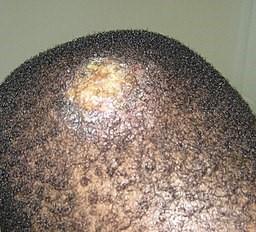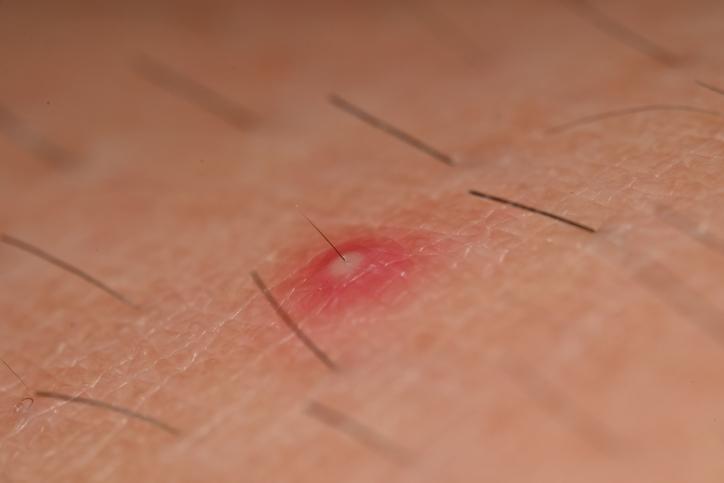Fungal scalp infection
Scalp ringworm
Peer reviewed by Dr Colin Tidy, MRCGPLast updated by Dr Philippa Vincent, MRCGPLast updated 19 May 2023
Meets Patient’s editorial guidelines
- DownloadDownload
- Share
- Language
- Discussion
Ringworm is a skin infection caused by a fungus (not a worm). Ringworm on the scalp mainly affects children, particularly of African or Caribbean origin. Treatment is with antifungal medication which is needed for several weeks. An antifungal shampoo is not usually effective alone but may be advised in addition to medication.
In this article:
Continue reading below
What is ringworm?
Ringworm is a fungal skin infection. (It is not due to a worm as its name implies!) There are many types of fungal germs (fungi) and some can infect the skin, nails and hair. This leaflet just deals with scalp ringworm which is sometimes called tinea capitis (from the Latin word caput, meaning head).
For information on other fungal infections, see the separate leaflets called Ringworm (Tinea Corporis), Athlete's Foot (Tinea Pedis), Fungal Groin Infection (Tinea Cruris) and Fungal Nail Infections (Tinea Unguium).
What causes scalp ringworm?
Most cases of scalp ringworm are caught from person to person via touching, sharing towels, etc:
Fungi and their spores can remain alive on combs, brushes, unwashed towels, furniture and sheets for long periods.
Some people are carriers of the fungi. That is, they have fungi on their skin and hair but these do not invade into the skin to cause infection or symptoms. However, they may pass the fungi on to others who then do develop symptoms.
Sometimes an outbreak of scalp ringworm occurs in families or schools.
From animals. Some dogs, cats and other pets have fungal infections on their skin. They can pass on the infection, especially to children. (Animals can be treated too if a pet is the cause - vets can advise further). Farm animals can also be a source. Touching a farm gate where infected animals pass through may be enough to infect the skin.
No apparent reason. Fungi are common and an infection can occur 'out of the blue'. For example, fungal spores can get into the air from an infected person and land on the scalp of another person. The spores may then develop into fungi and cause infection.
Scalp ringworm mainly affects young children. It is uncommon in adults. This is thought to be because the normal skin oil (sebum) that increases on the scalp in the teenage years (after puberty) has properties that make it resistant to fungi.
Continue reading below
What are the symptoms of scalp ringworm?
Tinea capitis

By 'Myself', CC BY-SA 4.0, via Wikimedia Commons
Commonly, the infection just looks like severe dandruff on various places on the scalp. This may be mistaken for psoriasis.
Some infections cause patches of hair loss (bald patches) to develop. The bald patches are usually inflamed and scaly. Small broken-off hairs may remain scattered in the bald patches.
In some cases, several painful boils (pustules) develop on the scalp.
A more severe infection develops in a small number of cases. This causes a large 'boggy' swelling in a section of the scalp, called a kerion. This can be oozing and tender and, if not treated early, can cause permanent scarring and hair loss. (Read more of this below, in the paragraph about complications).
If there is a severe infection, such as a kerion or pustules, a high temperature might develop and the glands in the neck may swell.
How is a scalp ringworm diagnosed?
Sometimes the symptoms strongly suggest a fungal infection. However, scalp ringworm may be confused with other problems at first. For example, some cases can look like psoriasis or bad dandruff and fungal infection is just one of several causes of bald patches and hair loss.
To confirm the diagnosis, a doctor will sometimes send a hair sample or a scraping of affected skin to the laboratory. This is looked at under the microscope and cultured to confirm that a fungal infection is the cause of the problem.
Continue reading below
General advice if you are diagnosed with scalp ringworm
If a child (or adult) is confirmed as having scalp ringworm then:
Where possible, objects that may be contaminated with fungal spores should be thrown away or disinfected with bleach - for example, hats, combs, pillows, blankets and scissors. This aims to prevent re-infection after treatment and to prevent passing on the infection to others.
Towels should not be shared and towels should be washed frequently.
It is not necessary to keep children off school. However, to ensure that the infection is not transmitted to others, they should carefully follow the recommended treatment.
The scalps of other children in the household should be checked and monitored. If there are any signs of scaling or hair loss then medical advice should be sought.
If a pet is suspected of being the source of the fungal infection then advice should be sought from a vet.
What is the treatment for scalp ringworm?
Antifungal medicines
An antifungal medicine taken by mouth is needed to clear scalp ringworm. They usually work well.
Griseofulvin has been the first choice of treatment for scalp ringworm for many years. An 8- to 12-week course of griseofulvin is usually needed. At the moment there is no liquid form available but the tablets can be taken crushed, if necessary mixed with a little water, for children unable to swallow them whole.
Terbinafine is another option which is being increasingly used instead of griseofulvin. Strictly speaking, it is not licensed for this purpose but it is often an effective treatment. A four-week course is usually needed. It is important to finish the course to clear the fungus completely from the scalp.
Other antifungal medicines, such as itraconazole and fluconazole, are sometimes used.
Antifungal medicines are generally well tolerated and side-effects are uncommon. However, they do occur in some people and some people should not take them at all. For example, women of childbearing age should not become pregnant during (and for one month after) treatment with griseofulvin. Men should use contraception during (and for six months after) their own treatment with griseofulvin, as it has been known to damage sperm.
Therefore, it is important to read the leaflet that comes with the medicine packet for a full list of cautions and possible side-effects before taking any treatment.
Antifungal creams and shampoos
Antifungal creams or shampoos do not clear the infection fully. This is because fungi get into the hair shafts where creams and shampoos cannot reach. Therefore, they cannot cure the condition. They do, however, clear fungi and fungal spores from the hairs and surface of the scalp.
An antifungal shampoo or cream may be advised twice-weekly for a couple of weeks in addition to antifungal medication - for example, selenium shampoo, ketoconazole shampoo or terbinafine cream. This is to clear any surface fungi quickly and make it much less likely for the fungus to spread to other children.
Are there any possible complications?
If the infection is not treated and becomes severe, there is a risk of some permanent scarring and patches of hair loss (bald patches) remaining on the scalp even after treatment.
Sometimes the fungal infection beds down deeply into the scalp, which responds by creating a very sore, thick bumpy mass of fungal infection called a kerion. This can look like a cluster of boils and be mistaken for a bacterial infection, when the actual infection is caused by a fungus.
Antibiotics will not help for a kerion: antifungal tablets like terbinafine or griseofulvin are needed. This image shows a kerion:
Kerion on a child's scalp

By Grook da oger, CC BY-SA 4.0, via Wikimedia Commons
Very occasionally the inflammation caused by a fungal infection can lead on to a 'secondary' bacterial skin infection. If this occurs then a course of antibiotics might be needed.
What about close contacts of affected people?
Some people with no symptoms may be contaminated with fungi in their hair. These people are called 'carriers'. Therefore, household members and other close contacts of an affected person may be advised to have a simple test. A special brush may be used on their hair which is then sent to the laboratory to see if their hair is contaminated with fungi or fungal spores.
Treatment of close contacts
Treatment may be offered if fungi or fungal spores are detected, to prevent the disease from 'taking hold' or from spreading to others. For example, some people found to have a heavy growth or high spore count may be advised to take a course of antifungal tablets.
Others with a low count may be treated with just an antifungal shampoo or cream.
Patient picks for Hair and scalp problems

Skin, nail and hair health
Folliculitis
Folliculitis means inflammation of the hair follicles of the skin. Most of the skin is covered with tiny hairs which grow out of hair follicles. In folliculitis, many hair follicles in one area of the skin are affected.
by Dr Philippa Vincent, MRCGP

Skin, nail and hair health
Alopecia areata
Alopecia areata is a condition where patches of hair loss develop, usually on the head. In some cases, total baldness develops. Usually the hair regrows after several months. In some cases, the hair loss is permanent. Treatments to promote hair regrowth work in some cases, but often the hair regrows of its own accord.
by Dr Philippa Vincent, MRCGP
Further reading and references
- Gonzalez U, Seaton T, Bergus G, et al; Systemic antifungal therapy for tinea capitis in children. Cochrane Database Syst Rev. 2007 Oct 17;(4):CD004685.
- Coulibaly O, Kone AK, Niare-Doumbo S, et al; Dermatophytosis among Schoolchildren in Three Eco-climatic Zones of Mali. PLoS Negl Trop Dis. 2016 Apr 28;10(4):e0004675. doi: 10.1371/journal.pntd.0004675. eCollection 2016 Apr.
- Pai VV, Hanumanthayya K, Tophakhane RS, et al; Clinical study of Tinea capitis in Northern Karnataka: A three-year experience at a single institute. Indian Dermatol Online J. 2013 Jan;4(1):22-6. doi: 10.4103/2229-5178.105461.
- Fungal skin infection - scalp; NICE CKS, July 2022 (UK access only)
- Kerion; DermNet.
- Tinea Capitis; British Association of Dermatologists, 2017
- Tinea Capitis; DemNetNZ
Continue reading below
Article history
The information on this page is written and peer reviewed by qualified clinicians.
Next review due: 12 May 2028
19 May 2023 | Latest version

Ask, share, connect.
Browse discussions, ask questions, and share experiences across hundreds of health topics.

Feeling unwell?
Assess your symptoms online for free
Sign up to the Patient newsletter
Your weekly dose of clear, trustworthy health advice - written to help you feel informed, confident and in control.
By subscribing you accept our Privacy Policy. You can unsubscribe at any time. We never sell your data.